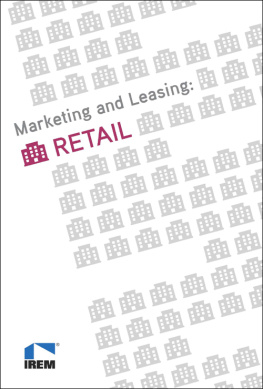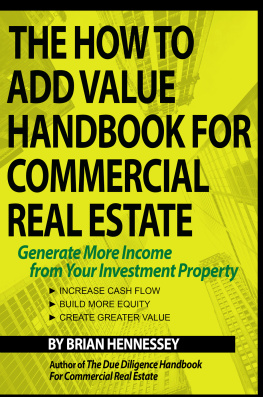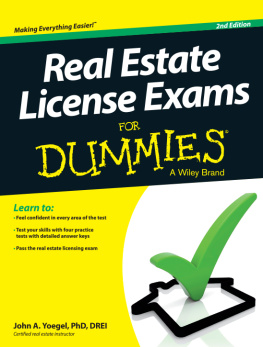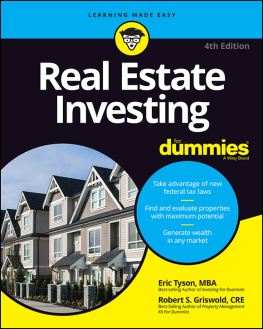Copyright 2019 Alice Devine
All rights reserved.
No part of this book may be reproduced, or stored in a retrieval system, or transmitted in any form or by any means, electronic, mechanical, photocopying, recording, or otherwise, without express written permission of the publisher.
Published by Learn Associates Publishing
Belmont, California
www.suitedealbook.com
Design: Paul Barrett
Editorial: Alexander Rigby, Valerie Paquin, Kari Somerton
Image credits: Halkin Mason Photography
ISBN (paperback): 978-1-7335307-0-5
ISBN (ebook): 978-1-7335307-1-2
Dedicated to William Wilson & Associates for its visionary leadership and quality real estate developments
Contents
Preface
Commercial real estate is a go-go business that thrives on hip architecture, charismatic people, and the thrill of a deal. The process of learning how to acquire and retain quality tenants, however, resembles a glacier moving ever... so... slowly. Why? Perhaps because real estates standard field training remains somewhat haphazard. Perhaps because its traditional culture limits access. Perhaps because leasing is part science, part artprecise business terms and intuitive skills. Perhapsprobablybecause of all of the above.
As I started my career in real estate, I discovered that my contemporaries who had been hired in other industries benefited from robust training programs designed to expose them to the many facets of their chosen businesses. In contrast, my training was informal and largely dependent on the quality of my mentors, whom, as I came to understand, I was lucky to have had at all. A further complication was commercial real estates notoriously old-boy atmosphere, which was entirely new territory for me. And acquiring the skills I needed to succeed as a property manager and leasing professionalboth the analytical and people skillstook time. The beginning of my career was a baptism of fire that sometimes ended in a spectacular flameout of defaulting tenants and muddied lease terms.
Over the years, the companies for which I worked managed, bought, built, and renovated commercial properties. As landlords, we leased millions of square feet of office space and established close working relationships with quality tenants who became famously reluctant to leave our buildings. Through it all, I found I had a well-developed sense for leasingan instinct, honed by experience, that told me a deal was ours to close, even in the early tour stages.
Why care about upping your leasing skills? Because effective leases add value to properties. Lets do some simple math. Suppose, for example, that you negotiate a mere 5 cents per square foot per month more in rent because youve read this book. Thats 60 cents per square foot per year. In a 100,000 square foot building, the increased rental rate translates to $60,000 more in annual revenue. Capped at 6% (more about this in ), that additional rent has added $1,000,000 to the buildings value! So leasing matters for a propertys value... and it translates to ones professional worth.
This book is intended primarily for those in commercial real estate whose responsibilities include leasing (or some aspect of it), and will benefit property managers, asset managers, landlords, leasing agents, and brokers. Having said that, much of this leasing discussion will benefit those who work with multifamily properties as well. The book is divided into three main sections: preparing to lease space, structuring the lease deal, and closing the lease deal. The chapters mirror the extensive training program I have designed and taught to commercial property managers. My intent is to be practical and sequential, and to speak to the realities of leasing.
Of course, in real estate, daily life rarely follows the neat sequence of a book, so take a deep breath and appreciate this crazy business for its infinite variety. You might be thrust into a tour of vacant space your first day on the job. A tenant might ask you about renewing a lease as you stand waiting for coffee. You mightlucky youinherit a property, and although there may be a leasing team in place, youll want to understand how the market works. Your only certainty is that each day will be different from the last.
My grandfather once suggested, Begin where the other person left off. Failing to listen to his advice, I undoubtedly retraced steps taken by others. This book gives you the opportunity to forge your own path with the benefit of others experiences and knowledge. I have tried to write in such a way that regardless of what leasing challenge you may encounter, you will be able to turn to a chapter and obtain help toward a solution. If my experience is any guide, the more problems you are able to solve, the better you will become at what you do. Inside, you will find practical leasing advice and real-life stories (in italics) gathered over hundreds of transactions. (As a note, the words landlord and owner are used interchangeably in this book, as are the words broker, agent, and salesperson.)
Like most real estate documents, this one contains a disclaimer. This book is not intended to offer legal or accounting advice, but rather to serve only as a guide relevant to the daily tasks of leasing. For those subjects where legal or financial advice is required, you should seek the advice of professionals in those fields.
Id love to hear from you about what works, what doesnt, and your own leasing experiences. Please visit my website, www.devinerealestateguide.com , for discussion, news, and relevant leasing topics. So hang on to your purses and wallets, and lets go.
Part I
Preparing to Lease Space
Chapter 1
Understand the Local Market
I want to see everybody in their habitat.
Sam Zell, founder, Equity International and real estate magnate
Goal: Understand the Local Real Estate Market in Order to Position a Property Competitively
One afternoon, I received a telephone call and was hired to lease and manage a million square feet of commercial office space on the San Francisco Peninsula. Initially elated, I soon became concerned. Although a native San Franciscan, I knew little about the small towns south of the city and just north of Silicon Valley where this new portfolio was located. The area seemed an eclectic mix. One town boasted a card casino open twenty-four hours while the next towns tree-lined roads obscured mansions that housed CEOs and heirs to fortunes. Soon, office space featuring Ping-Pong tables for hoodie-clad techies would become fashionable. In the meantime, I needed to understand this marketplace. One of the first things I did was call the broker whose number was posted on a leasing sign at a large building in the area. Over the next three years, this broker helped me understand the market and, in the process, became a trusted friend.
Its said that commercial real estate professionals only care about the space within an hours driving distance from their pillows. That quip underscores accurately the very local nature of real estatefor many, only the buildings within their competitive market affect their daily leasing lives. It follows that by focusing on your immediate real estate market and its competing buildings, you can position your own property for leasing success.
Learning about your local market allows you to succeed within it. Quantitatively, you must know and understand the features of the area, its inhabitants, properties, economics, culture, geography, and nuances.













